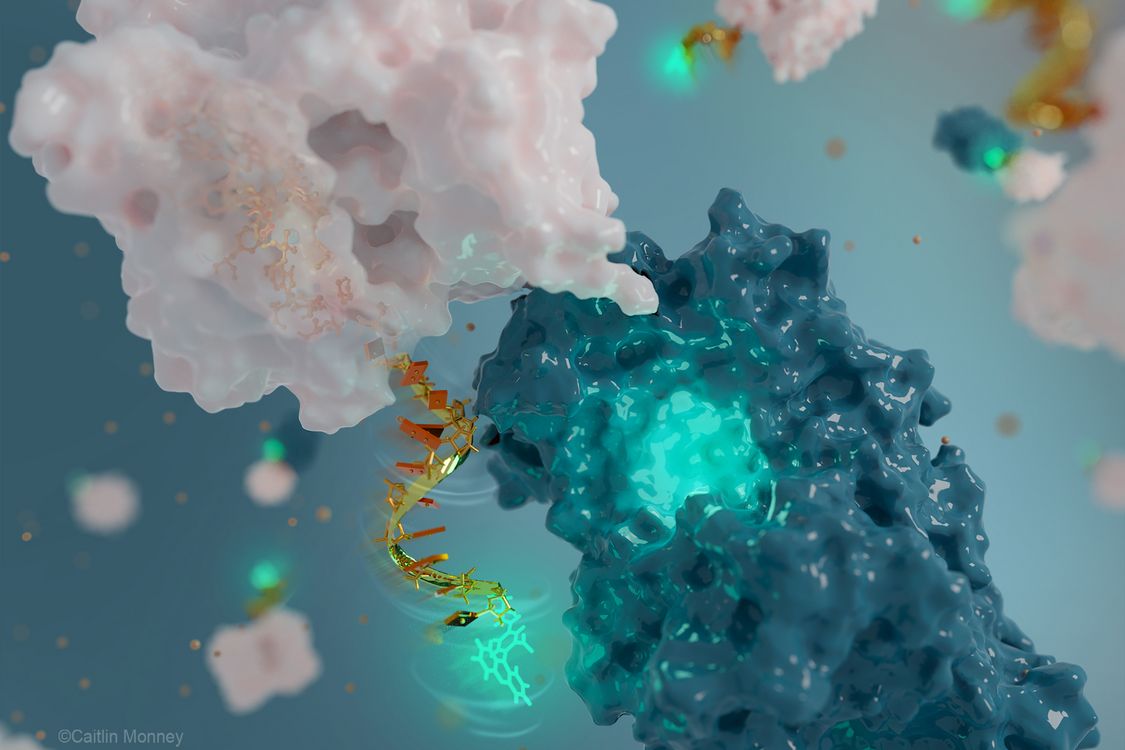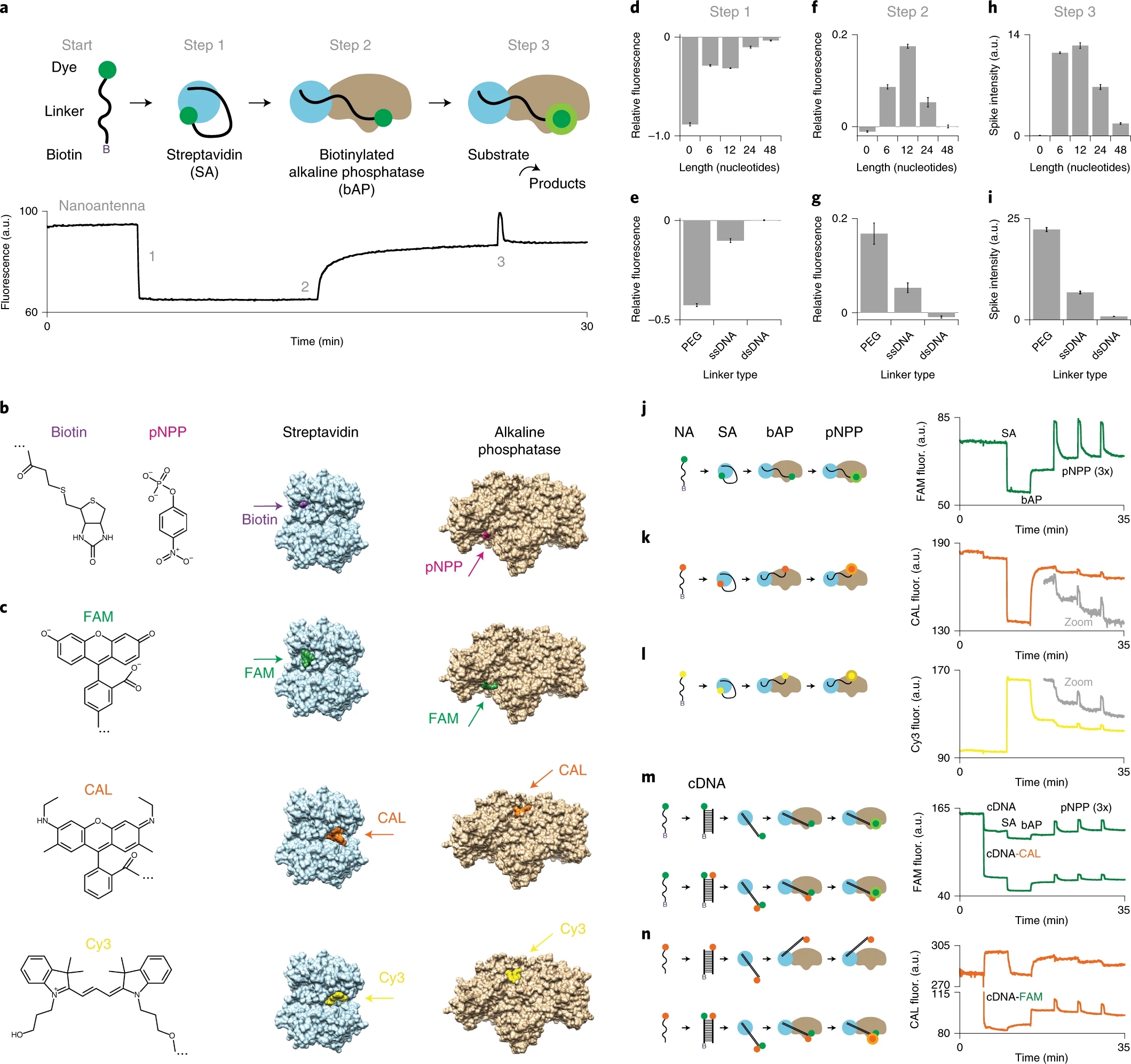化学家利用DNA建造了世界上最小的天线
诸平

Like a two-way radio that can both receive and transmit radio waves, the fluorescent nanoantenna designed by Alexis Vallée-Bélisle and his team receives light in one colour and depending on the protein movement it senses, then transmits light back in another colour, which we can detect. One of the main innovations of these nanoantennas is that the receiver part of the antenna (bright green) is also employed to sense the molecular surface of the protein studied via molecular interaction. Credit: Caitlin Monney

Fig. 1: Overview of the fluorescent nanoantenna strategy to probe different regions on a protein.
据加拿大蒙特利尔大学(University of Montreal/Université de Montréal简称UdeM)2022年1月10日提供的消息,该校的化学家利用DNA建造了世界上最小的天线(Chemists use DNA to build the world's tiniest antenna),这种纳米天线可以来监测蛋白质的运动。相关研究结果于202112月30日已经在《自然方法》(Nature Methods)杂志网站发表——Scott G. Harroun, Dominic Lauzon, Maximilian C. C. J. C. Ebert, Arnaud Desrosiers, Xiaomeng Wang, Alexis Vallée-Bélisle. Monitoring protein conformational changes using fluorescent nanoantennas. Nature Methods, 2022, 19: 71–80. DOI: 10.1038/s41592-021-01355-5. Published: 30 December 2021. https://www.nature.com/articles/s41592-021-01355-5
此文报道的该装置是一种监测蛋白质结构随时间变化的新方法,可能有助于科学家更好地理解自然和人类设计的纳米技术。UdeM化学教授Alexis Vallée-Bélisle是这项研究的通讯作者,他说:“这个结果非常令人兴奋,我们目前正在努力建立一家初创公司,将这种纳米天线商业化,让大多数研究人员和制药行业都能使用它。”

天线的工作原理就像双向无线电(An antenna that works like a two-way radio)
40多年前,研究人员发明了第一个DNA合成器,用来生成编码遗传信息的分子。“近年来,化学家们已经意识到DNA也可以用来构建各种纳米结构和纳米机器,”担任加拿大生物工程和生物纳米技术研究主席、参与此项研究的人员补充道。
他说:“受DNA‘类乐高(Lego-like)’特性的启发,我们已经创造了一种DNA荧光纳米天线,它可以帮助描述蛋白质的功能。”.
“就像一个既能接收又能发射无线电波的双向无线电(two-way radio)一样,荧光纳米天线接收一种颜色或波长的光,然后根据它感知的蛋白质运动,将光线传回另一种颜色,我们可以检测到。”
这些纳米天线的主要创新之一是,天线的接收器部分也被用来通过分子相互作用来感知蛋白质的分子表面。
蒙特利尔大学(UdeM)化学博士生,也是该研究的第一作者斯科特·哈伦(Scott Harron)说:“利用DNA来设计这些纳米天线的主要优势之一是,DNA化学相对简单且可编程。这种基于DNA的纳米天线可以以不同长度和灵活性合成,以优化其功能。我们可以很容易地将荧光分子附着在DNA上,然后将这种荧光纳米天线附着在生物纳米机器上,比如酶。通过仔细调整纳米天线的设计,我们已经创造了5个纳米长的天线,当蛋白质执行其生物功能时,此天线产生一个独特的信号。”
斯科特·哈伦说:“例如,我们能够第一次实时检测碱性磷酸酶(alkaline phosphatase)与各种生物分子和药物的功能。这种酶与许多疾病有关,包括各种癌症和肠道炎症。”
这项研究的合作者之一、正在UdeM攻读化学博士学位的多米尼克·洛宗(Dominic Lauzon)补充说:“除了帮助我们了解自然纳米机器功能或故障,因此导致疾病之外,这种新方法还可以帮助化学家识别有前途的新药以及指导纳米工程师开发改进的纳米机器。”
科学家们说,这些纳米天线能够成为可能的一个主要进步也是它们的易用性。
Alexis Vallée-Bélisle说:“也许最让我们兴奋的是,世界上许多实验室都配备了传统的荧光光谱仪,可以很容易地利用这些纳米天线来研究他们喜欢的蛋白质,比如识别新药或开发新的纳米技术。”
上述介绍,仅供参考。欲了解更多信息,敬请注意浏览原文或者相关报道。
Understanding the relationship between protein structural dynamics and function is crucial for both basic research and biotechnology. However, methods for studying the fast dynamics of structural changes are limited. Here, we introduce fluorescent nanoantennas as a spectroscopic technique to sense and report protein conformational changes through noncovalent dye-protein interactions. Using experiments and molecular simulations, we detect and characterize five distinct conformational states of intestinal alkaline phosphatase, including the transient enzyme–substrate complex. We also explored the universality of the nanoantenna strategy with another model protein, Protein G and its interaction with antibodies, and demonstrated a rapid screening strategy to identify efficient nanoantennas. These versatile nanoantennas can be used with diverse dyes to monitor small and large conformational changes, suggesting that they could be used to characterize diverse protein movements or in high-throughput screening applications.
转载本文请联系原作者获取授权,同时请注明本文来自诸平科学网博客。
链接地址:https://blog.sciencenet.cn/blog-212210-1320750.html
上一篇:物质和反物质似乎对引力的反应是一样的